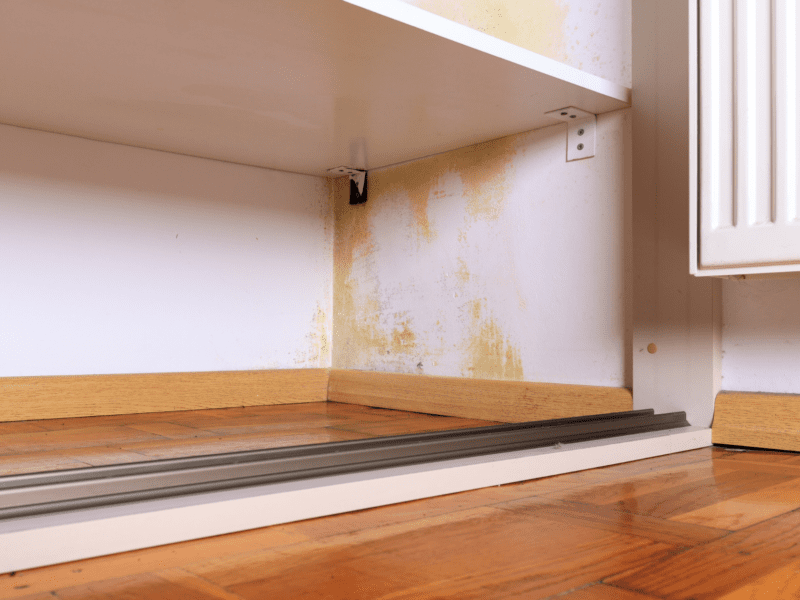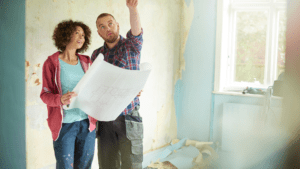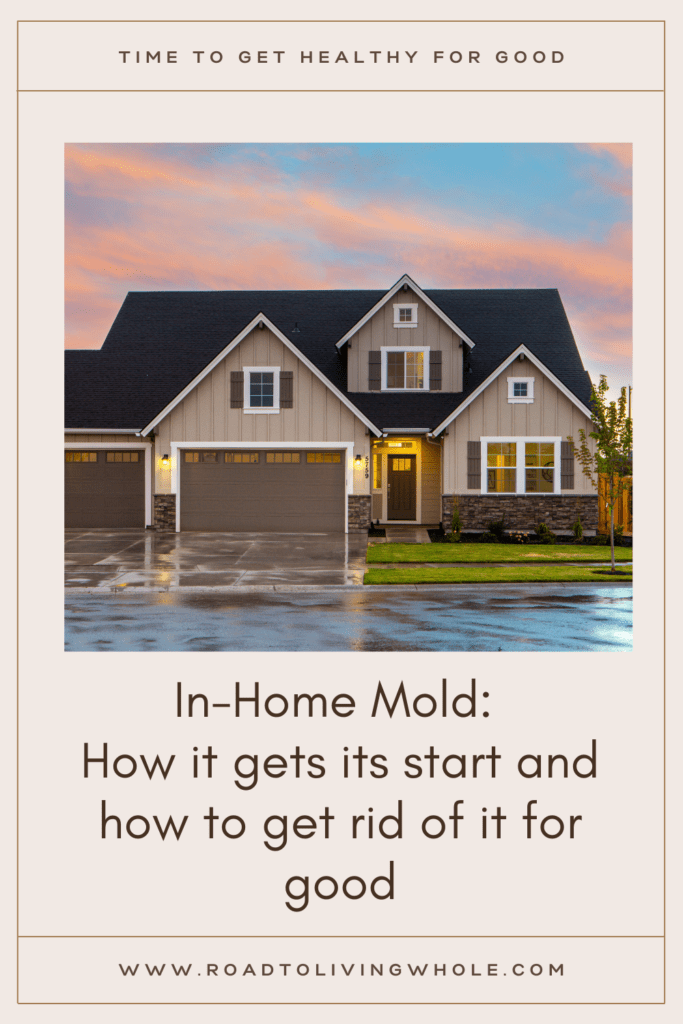Like most weather events, the recent winter storm that swept throughout most of the central united states caused a lot of damage. In Texas, video after video was uploaded of pipes bursting and flooding buildings. For those impacted by significant water events like flooding, time is of the essence. If homes affected by the recent winter storm are not addressed properly, there is no doubt that they will lead to an incredibly large number of sick homes. The result could put the occupants at risk of chronic illness for years to come. The good news? It can be prevented.
When it comes to water damage from a recent storm, the types of molds present in a building at any given time depend on the amount of moisture present, and how long the building materials have been wet. Primary colonizers are the first molds to grow after a water event and can grow in relatively dry conditions. As water activity in building materials increase, secondary colonizers begin to grow. If the water activity remains and nutrients are still available on the substrate, these molds will become the dominant fungi. Tertiary colonizers require water activity of 0.9 and above. The presence of these molds is in a building is an indicator of a significant water event. Tertiary colonizers include molds like Stachybotrys, Chaetomium, and Ulocladium. Actinomycetes and other bacteria would also fall into this category.
Regardless of how long it has been since the water event occurred, arguably the most important part of the entire process is a thorough inspection. In our experience, the fly-by-night storm chasing restoration companies are usually in and out of a property so fast that things get missed. Unfortunately, that leaves areas of water damage that get overlooked, ultimately leading to mold growth, an entire soup of pathogens, and a sick home that can lead to chronic illness for years to come. Since there is not a “one size fits all” approach to property damage, homeowners are much better off hiring an inspection company to thoroughly evaluate the home, perform sampling, and write a strategic protocol specific to their property to properly dry out / remediate the structure.

The First Step in Looking for Mold
The first thing that should be considered by the inspector is the type of water involved. There are three categories of water damage:
- Category 1 (Clean water): Category 1 water includes damage from water supply lines, sinks, bathtub overflows, and many appliances. This type of damage is less severe and considered “clean” because it is sewage and toxin-free (if it is dried out quickly).
- Category 2 (Grey Water): Category 2 damage includes water from toilets, washing machines, sump pump backups, etc.
- Category 3 (Black Water): Category 3 water is grossly contaminated and can contain pathogenic, toxigenic or other harmful agents. Examples of category 3 water can include but not limited to; Sewage, toilet backflows that originate from beyond the toilet trap regardless of viable color or content. All forms of flooding from seawater, ground surface water from raising rivers or streams, and other contaminated water entering or affecting the indoor environments, such as windblown rain from hurricanes, tropical storms, or other weather-related events, such water sources may carry silt, organic matter, pesticides, heavy metals regulated materials or toxic organic substances.
The Second Step
The second step is a moisture evaluation. This will consist of thermal scans, humidity readings, and moisture mapping with a moisture meter. The objective is to identify all impacted building materials and determine which walls should be removed. It is important to determine whether walls impacted have insulation as insulation can retain / wick moisture for an extended period, therefore needs to be removed.
The Third Step
Third, SAMPLE! Always sample. Since mold can begin to grow within 24 to 48 hours, it is important to validate if an unusual mold condition exists. Failure to identify the presence of mold inside of impacted walls cavities could results in cross-contamination of other areas of the home and/or the ventilation system during the restoration process.
The Remediation Protocol
Based on the type of water, moisture evaluation, and sampling a strategic remediation/restoration protocol should be provided by the inspection company. This will a step-by-step guide for the restoration company to follow to bring the home back to a healthy environment. It is strongly advised that the inspector be hired on the back end of the job (before any building materials go back up) to make sure the protocol was followed, all wall cavities were properly dried out, and perform sampling to validate the areas are clean.
What to Expect From Insurance
If there is one last piece of advice to offer when dealing with a catastrophic water loss is to use a public adjuster for any insurance claim. Public adjusters will negotiate and fight with your insurance company for the best settlement possible. They submit all the paperwork and communicate with the carrier to take that burden off your shoulders. A good public adjuster can make a huge difference in getting what you deserve to cover the damage in your home.
Where Mold Is Often Missed In Home Inspections
Unfortunately, not all water events are taken care of correctly. To go along with that, not all water events are as obvious as a weather event or some sort of flooding. In fact, most are hidden and can go undetected for extended periods of time. This has led to an epidemic of sick homes. According to the EPA, approximately 50% of all buildings in the United States have been affected by water damage. In our experience, we believe that number to be higher since the statistic only considers reported events. Even new construction homes have shown to have significant issues due to poor quality of work with how fast they are being built. This puts immune-compromised individuals at high risk of being exposed to biotoxins in their homes or workplaces.
It cannot be stressed enough how important a thorough inspection is. This inspection sets the road map for remediation and REALLY BIG decisions down the road regarding belongings, the ventilation system, or in some cases whether the homeowner’s doctor even feels comfortable with their patient staying in the home at all. In our experience, most failed remediation horror stories you read about online happen for at least one of the following reasons:
Poor Inspection:
The old phrase “you get what you pay for” could not be any truer when it comes to inspecting your home for mold/water damage. Inspectors now are so dependent on random air samples that all too often they get through a house without doing what they were actually hired to do, inspect the house. Without a comprehensive inspection using both your eyes and a wide range of equipment, it is easy to miss source areas that need to be removed.
HVAC was Ignored:
The air handling unit is the lungs of the home. The HVAC needs to be sampled pre- remediation to understand how it needs to be cleaned or replaced.
Cross Contamination was not taken into consideration:
The home works as one living and breathing system. Once mold spores, mycotoxins, fragments, and endotoxins aerosolize they can move into other areas of the home through the ventilation system or even just changes in pressure. This can lead to contamination of contents throughout the home.
To avoid the horror story, make sure to invest in a certified mold inspector and remediator (two separate companies to avoid a conflict of interest) who are experienced in working with sensitive clients. These companies should be familiar with how to perform a thorough inspection and the necessary tools/testing to form a comprehensive remediation scope of work. A thorough inspection doesn’t just begin and end with the physical inspection, it is a multi-step process to ensure the homeowner is left in a position with all the information they need to make educated decisions.
The 6-Step Process To Testing Your Home For Mold
Learn the history of the property.
The first conversation with the client is one of the most important steps in the process. We take this time to LISTEN to the client’s health concerns and discuss the current condition of the property. We spend time LEARNING about the history of the home and any remediation previously performed. Information communicated during this conversation could lead to identifying source areas of contamination during the investigation.
Visual inspection.
We begin by walking the property with the client to understand all areas of concern discussed on the phone. We then walk the perimeter of the home to identify any potential source areas of water infiltration. A wide range of equipment is used inside of the home to help us perform a comprehensive assessment.
Develop & explain the sampling plan.
The sampling plan should be strategic to help understand the home from a holistic standpoint. Specific sample types and quantities depend on the inspection, history of the home, and the condition of the environment.
Sample collection.
There is not one perfect sampling methodology. Collecting a wide variety of samples is important when dealing with hypersensitive individuals. All samples are sent to a third-party accredited laboratory.
Provide a comprehensive report with lab results and recommendations.
The inspector should provide a comprehensive report including the mold remediation strategy.
Review the findings, reports, and recommendations.
It is extremely important that the client understands the protocol and additional recommendations. All reports should also be reviewed with the remediation contractor.
Here’s What You Can Expect Next
 Once the inspection process is completed and all reports have been reviewed, it is time to find a mold remediation contractor. Keep the inspector involved in the vetting process to ensure the company is capable of successfully performing the protocol. Depending on the health sensitivities of the client and lab results, mold remediation may have to be performed in a two-step process. Phase one consists of remediating the sources. During this phase, the areas where mold was identified must be put under proper containment. All HVAC units are turned off and registers are sealed to prevent cross-contamination. All contents are sorted or removed depending on if it is porous or not. Contaminated building materials will be removed from the containments and all surfaces cleaned and sanitized following remedial guidelines.
Once the inspection process is completed and all reports have been reviewed, it is time to find a mold remediation contractor. Keep the inspector involved in the vetting process to ensure the company is capable of successfully performing the protocol. Depending on the health sensitivities of the client and lab results, mold remediation may have to be performed in a two-step process. Phase one consists of remediating the sources. During this phase, the areas where mold was identified must be put under proper containment. All HVAC units are turned off and registers are sealed to prevent cross-contamination. All contents are sorted or removed depending on if it is porous or not. Contaminated building materials will be removed from the containments and all surfaces cleaned and sanitized following remedial guidelines.
Phase two kicks off a full home cleanse. This means the entire home undergoes a deep cleaning. All items should be removed from the home to allow unhindered access for proper cleaning. Depending on the lab results, porous belongings should be properly discarded. Air scrubbing with HEPA air scrubbers and a wipe down of all surfaces is performed. Fogging the home will suppress the ultra-fine particles, mold fragments, mycotoxins, and endotoxins to bring them to the ground so they can wipe down with microfiber cloths and physically removed from the environment.
Regardless of how good your remediation company is or how good the property looks after the project, it is vital to sample again BEFORE any building materials go back up. A post-remediation verification inspection will consist of the inspector making sure all remediation protocol was performed, no visible growth is still present, and sampling the source area and ventilation system to validate everything is back to a normal fungal ecology.
Feeling Sick Post Mold Remediation?
If clearing out the mold didn’t resolve your physical symptoms, you may have developed mold toxicity. You can learn more about what that looks like and strategies to recover in this workshop.
Meet The Author
 Sean McGrath is a Certified Indoor Environmentalist (CIE) accredited through the American Council for Accredited Certifications, as well as, a licensed Mold Assessor in the state of Florida. His role with CMA includes Inspections, Analysis, and Project Management. Sean’s expertise is identifying source areas of potential mold growth within a building in order to develop a strategic sampling plan and remediation strategy. Sean is an environmental consultant drawn to this business by his passion and desire to help those suffering from environmental illnesses. His ability to work with clients throughout the entire process in a professional comforting manner differentiates him from other environmentalists. His thirst to seek out the latest developments and information that can be used to help his clients is refreshing. Sean has performed over 1500 inspections since joining the Certified Mold Assessments Team. www.certifiedmoldassessments.com
Sean McGrath is a Certified Indoor Environmentalist (CIE) accredited through the American Council for Accredited Certifications, as well as, a licensed Mold Assessor in the state of Florida. His role with CMA includes Inspections, Analysis, and Project Management. Sean’s expertise is identifying source areas of potential mold growth within a building in order to develop a strategic sampling plan and remediation strategy. Sean is an environmental consultant drawn to this business by his passion and desire to help those suffering from environmental illnesses. His ability to work with clients throughout the entire process in a professional comforting manner differentiates him from other environmentalists. His thirst to seek out the latest developments and information that can be used to help his clients is refreshing. Sean has performed over 1500 inspections since joining the Certified Mold Assessments Team. www.certifiedmoldassessments.com
Certified Mold Assessments was founded in 2011 by company President Al Rabin. CMA is a company dedicated to the detection and prevention of mold and other pathogens in indoor environments in Florida, Texas, and throughout the southeast. We provide professional services for mold inspections, testing, and preventive maintenance. Every inspection project is personally supervised and conducted by a trained Certified Mold Inspector and Certified Indoor Environmentalist committed to providing the utmost integrity and maintaining the highest standards in the environmental inspection profession. Every investigation performed is geared toward understanding and improving the health of our clients and the health of their homes.









